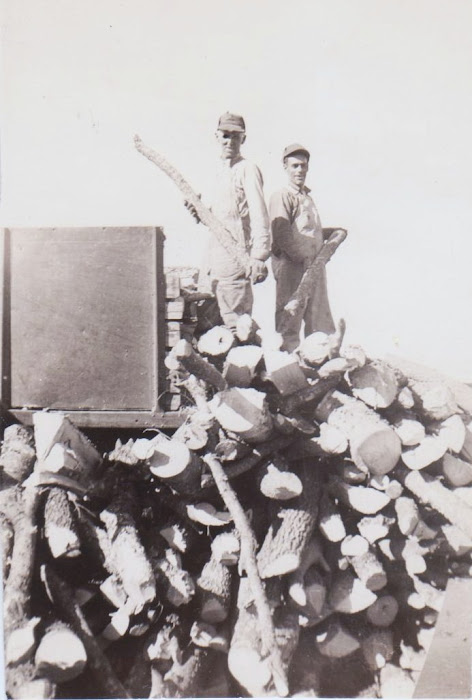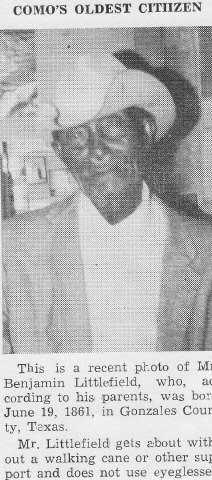I have posted an account of an early African American neighborhood in Fort Worth, Texas.
I saw a short comment in Wikipedia about the place and felt the need to more fully acquaint people with its history and a few of the colorful individuals who lived there. Most of the people who were familiar with its earliest origins over 100 years ago are dead, so I'm the only one who is likely to tell its story using a web blog. This account is based upon how I remember my community. I include something about nearby Benbrook, two miles away, where I worked for the Willburns, direct descendants of the mid-1800s white pioneering family who settled there when the city of Fort Worth was also being established. I am very glad to be able to tell some interesting facts about Lake Como which many who live there now do not know.
The name for my Blog, "Warm Prairie Wind," is used to describe the delightful caress of the gentle warm spring and early summer winds that blew from the southwest across west Fort Worth and its prairies.
Charles E. Cannon
Warm Prairie Wind Blogspot.com
July 25,2009
The text below was produced from an electronically scanned copy of the 24th ANNIVERSARY SUPPLEMENT FORT WORTH COMO WEEKLY__1940-1964, and published in 1964 by Mr. William Howard Wilburn of Lake Como, Editor–in-Chief.
Editor Wilburn says: "Mrs. (Rubye) Jones wrote our historical sketch of the beginning of the Como Community, covering that period from 1908 through the 20's, having her self, been born and raised in the Como community."
Precaution has been taken to preserve originality, with the exception of format. All punctuation, grammar, and spelling errors have been retained as they appear in the original document, which consists of 62 pages including front and back covers.
Due to technical difficulties only the history sketch is reproduced here. Many photographs and other information have been omitted.
Warm Prairie Wind wishes to thank Mr. James Cass of Oakland, California, a former early Lake Como resident, for providing the booklet that is the source for this historic document. This document can also be found in the Genealogy History Archives of the Fort Worth, Texas Public Library.
STORY OF THE COMO COMMUNITY
The history of our community is an interesting one. This community started about the year 1905 or 1906, as a pleasure resort. The lake was considered to be the show place of Fort Worth. There were (about where the present shelter house stands) concessions, a board walk, dance pavilion, movie house, shooting gallery, a fun house, etc. Swimming was a much enjoyed sport. On the north side of the lake three masonry buildings housed machinery for pumping water to this part of Arlington Heights. The few families who lived in Como at that time hauled water in barrels on wagons from this pumping station. A streetcar line ran to the north side of the lake to bring pleasure seekers to the resort.
Some prominent families who lived and owned property on the north side of the lake were the Lawrences, Haws, Boldridges, Kin-cannons, Sanguinettes, Overmeyers. On the south side or the Como side, on the land where the James P. (Patrick) Wicks' home is located today, there lived a Mr. Lloyd and his family.
Feeling the need of a college, a group of Baptist ministers combined their ideas and started the old I. and M. College on the land that is south of Humbert Street in the 5300 block to the 5500 block extending south to Helmick. To be near the college so their daughter could attend, Mr. and Mrs. Smith moved to Como. Their daughter, now a retired school teacher of the city, Mrs. Ruby E. Jeffery, lives at 1033 E. Leuda.
The leaders and prominent ministers connected with the college were Rev. L. M. Johnson the father of Professor L. M. Johnson, retired principal of I. M. Terrell High School, Rev. L. K. Williams, Mr. Boone, and a Rev. Scott who lived in the community with his family.
After a flood in what was called the "Bottom" near the Purina Mills, several families who were victims of the flood moved to this new community; among them were Mr. and Mrs. Johnny Crawford and their son Richard. When they arrived in 1909, they found Mr. and Mrs. Fernander Cook a son; the Smiths, a family of Dewitts and their daughters. The Dewitt home stood where the present parsonage of Johnson Chapel Church stands today. There were two families of Skeltons—brothers—Ed and Sam. Of that family, a son, Eddie still lives. A family of Islers, relatives of Mrs. Cora Atkinson of 5336 Diaz, lived near the college. A Rev. Brown and family and a Mr. Neal, who lived near where Como High School now stands, were also early settlers to this community.
After World War I, because of a lot sale by Dicherson, Trentman, Tarlton and other white realtors who sold lots for a dollar down, a number of people moved to the community. The college, because of the lack of funds, closed. Some of the buildings were torn down and moved to Houston, Texas, where a school was started.
Camp Bowie, an army camp, used part of Como as training ground during World War I. Trenches were dug and soldiers trained over much of the land.
The first public school was located in what is now the 5200 block of Helmick on top of the hill. Mrs. Lucinda Baker was the first teacher. This school finally closed and the pupils had to go by streetcar to James E. Guinn school on the south side.
As the community started growing at the close of World War I, the need for a school arose because of the increase of pupils in the community. School was held in one of the abandoned college buildings with Mrs. Tennessee Smith as teacher. After she left a Miss Pearl Walker (Mrs. Pearl Connas) came as teacher. Later a county school was built under the superintendency of Mr. R. N. Riddles whose office was then located where the Arlington Heights Elementary School now stands. The teacher was Mrs. Gertrude B. Starnes. She was joined later by a Mrs. Jessie B. Raleigh and Mrs. Geneva Carrington.
Some of the first families of Como were Mr. and Mrs. Curtis Bowles, Mrs. Elnora Bowles still lives, Mr. and Mrs. Brown—of this family a son Roosevelt Brown lives on the south side, Mr. and Mrs. S. C. Crook and daughters who ran the first dairy in Como. A family named Tippens—relatives of the Sheppards, the mother and father of Mrs. Hattie Wright and Mrs. Lovetta McPherson, were all members of this community, also Mr. and Mrs. Lavois—relatives of Mr. Branch of Goodman Avenue. In fact Mr. Branch lives on the land they owned at that time. Mr. and Mrs. Jesse Howard and family, some of their relatives, Luda Howard, Mrs. Eva Mae Jones and relatives, the Joe Sweeneys, Mr. and Mrs. Eugene Baker, the Ben Littlefields, and the Claud Hendersons, the Etta Wilsons, and the Elijah Whites were all pioneers of this great community.
The house now occupied by Mr. and Mrs. Ordeal Robinson at 5420 Wellesley Ave., was then occupied by a Bohemian family and is the oldest house in the block. A number of white families also lived in the community.
"Booger Red" and Ella Thompson lived at the present site of the C. W. Haley's on Kilpatrick Ave. Will Holland, the barber, moved in and out of Como during the period of 1912-15. Fred and "Dut" Lauderdale lived near Como First Baptist Church with their mother (Emma) and father. The Calvin Grants live in the house then occupied by Mr. and Mrs. Albert Anderson. He was a brother of "Sweet" Anderson on Houghton Ave. The late Dr. F. Rivers Barnwell, who taught at I. & M. College, lived on Humbert with their two children, Frederick and Evangeline. Mrs. Mary O'Brien, grandmother of Edward Richardson, lived next door to what is now Boozie's Lounge.
The first circuit preacher in Como was the Rev. Ford, a native of Louisiana and a Baptist. He was known as the "tongue-tied" preacher.
The first Sunday School was held in union, that is, Methodists and Baptists met together for Sunday School sessions and for want of a proper name, Mrs. Elnora Bowles insisted that the name, Union Sunday School, be its label, and, so it was.
The first public school building was heated with coke brought from the Stove Foundry by a patron of the school, Mr. F. W. Isler. Water was hauled in barrels from the college well and later from a well located on the east side of the lake.
Zion Baptist Church was then located on the north-west corner of Blackmore, 5700 block, and the pastor was a Rev. Quarles who held services in a tent.
After a flood in the northern part of the city (Quality Grove) a number of persons moved to Como. Among them were Mr. and Mrs. A. Woods who opened a grocery store. Property was being bought, houses were being built, and several energetic men led the community. In this effort was Angus Woods, Claud Henderson, Johnny Crawford, Juke Hemphill and Mr. Johnson. There was a great influx of people to the community and it has been growing ever since.
Lake Como 1933

Julia "Cricket" Nelson and Charles Cannon 1933
Willburn Family Haying about 1897

Willburn Family Haying about 1897. Reuben is the baby in white sitting on the hay bales above the black dog on the photo's right.
Reuben and Ruby Willburn Family Haying About 1936 At Benbrook

Reuben and Ruby Willburn Family Haying About 1936 At Benbrook
Reuben Wilburn And Pancho Early 1940s

Reuben Wilburn and Pancho stacking cordwood to be sold in Lake Como
Ben Littlefield, 103 years; Lake Como About. 1964

Ben Littlefield, Lake Como About. 1964
Momma Cannon and Club Members, at their own clubhouse about 1940

Ist botom row left to right,#1 ?, #2 Mrs.Willie (Momma) Cannon, #3 Mrs. Eula Johnson, #4 Mrs. ?, #5 Mrs. Joe Patterson; 2nd row l.to r., Mrs. Rubye (Crawford) Jones, Mrs. ?, Mrs. Rose Anderson, Mrs. Elaine Goodspeed; 3rd row, Mrs. Louis Brice, Mrs. ?, Mrs. Angus Woods, Mrs. Myrtis Garnet, Mr. ?. Top rows , Mrs. ?, Mrs. ?, Mr. ?; extreme top, Mr. ?, Mr. Rose Anderson, Mr. Levi Jones, Mrs ?. and Mr.?,
Tuesday, May 19, 2009
Subscribe to:
Comments (Atom)
